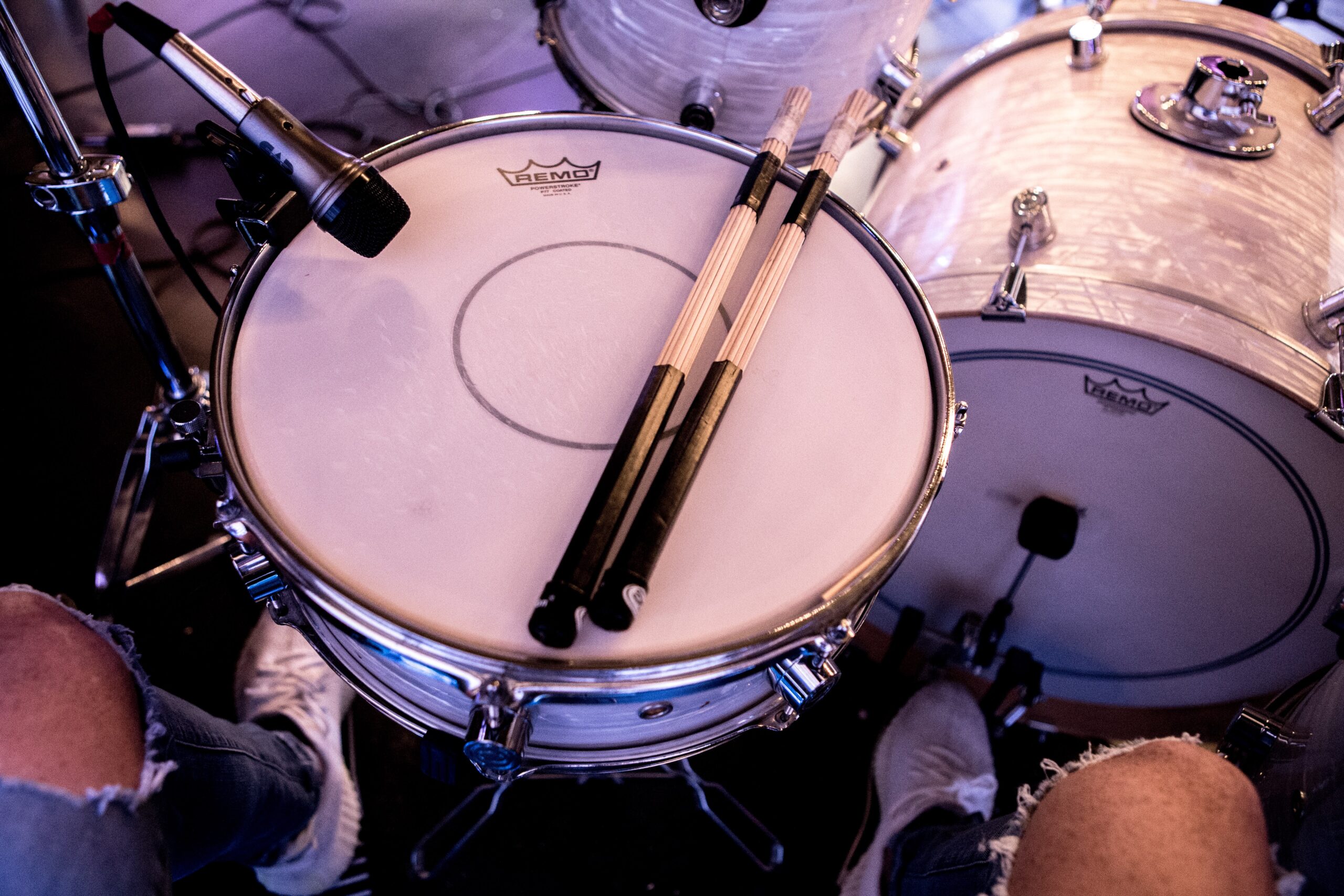Tuning your drums to perfection is one of the biggest problems for both novice and seasoned drummers. Drums come pre-tuned on purchase, however, it takes quite a lot of adjustments to find the tone that fits you right. The truth is, drum tuning isn’t all that difficult if you know where to start. This article will help you do that and cover:
- What do you need to know about tuning your drums?
- How to tune drums?
- How to know if your drums are in tune?
What You Need To Know About Tuning Drums
What Is Tuning
Tuning a drum is the tightening or loosening of the tension rods built on the side of the drum. This allows you to alter the pitch of the sound the drum will produce once struck. Ideally, you should have the same tension in all of the rods of the drum.
To tune a drum you need a drum key which is available in almost all drum sets. You tighten the rods to increase the pitch and loosen the rods to decrease it.

Why Tune Your Drums
Drums are not pitched instruments, however, even they need the occasional tuning. Tuning prevents the drums from going flat and helps removes overtones you don’t want. Drummers also tune their drums to shape the sound of their instruments to play specific types of music.
How Often to Tune Your Drum
People get confused about how often they should tune their drums, and there’s no fixed formula for it. You’re going to need to tune your drums depending on how often you use them, and how hard you hit them. Ideally, if you know what you’re doing and play your drums often, tune them once every two weeks at least.
There are a lot of tuning aids that can be a real help for new drummers. These aids measure the pitch of each rod of the drum. You can use these measurements to match the tension of all your rods. Tuning aids are also helpful when you need to tune drums in a kit to work well with each other.
Different Drums Are Tuned Differently
A drum kit is made of different types of drums. There are snare drums, toms, and bass drums, all of which are tuned differently. The drums must first be tuned by themselves, and then be tuned to match the rest of the kit.
Read Also: Top 5 Cheap Drum Sets Under 100
For a bass drum, you want to keep the head a little loose so that the beater doesn’t bounce too quickly from the drum. If the beater rebounds from the drumhead too fast you’ll hear unwanted double beats. For a tom drum, the pitch of the resonant head should be a tone higher than the batter head.
The snare head is the most difficult to tune because you need it to produce a clear and sharp sound. Tune the snare side of the drum until the sound gets choked (the snare sounds tight and muffled instead of crisp like it should be). Then loosen the tension rods a turn or two, and continue to adjust till your drum sounds right.
How To Tune Drums (7 Steps)
Step 1: Remove Your Drums Heads
A drum is made of two heads, the batter head, and the resonant head. Use your drum key to unscrew the tension rods in a counterclockwise motion until both the heads come loose. Leave the rods threaded through their lug casings.
Once the head and hoop become loose enough to freely spin on the shell, give the shell a tap and record its sound. This is the pitch you want to recreate after your drum is tuned.
Remove first the hoops and then the heads of the drum. Then wipe down your drum heads carefully, and clean the edges of the shell. Pay special attention to the bearing edge—where the edge of the drum’s shell meets the head’s skin—because debris there can cause significant damage to the sound quality.

Step 2: Install the Drumheads Back
Once you’re done with the cleaning, place the drumheads back on. Give each head a little spin on the shell so you know it’s centered. Then place the top and bottom hoop to hold the heads in place.
Use your fingers to turn the tension rods until you can’t tighten them anymore. This will fix the heads firmly in place, and allow you to use the drum key to tune it easily.
Step 3: Tighten the Rods of the Batter Head
Your tension rods control the pitch of your drum, so you need to make sure all of them have the same level of tension. The easiest way to do that is to turn the rods the same number of times.
Tighten the rods in an opposite and alternating pattern. Choose any rod to begin with and give it a turn. Then choose the rod that’s on the exact opposite side and tighten that. Skip a rod as you move counterclockwise on the drum and tighten the next one. Then move to the one on the opposite side and keep repeating until you’re done with all the rods.
For the best sound quality, you want the rods on opposite ends to match each other perfectly. You can always tighten or loosen the rods to increase or decrease the pitch.
We recommend using a tuning aid like Tune-Bot to measure the pitch of each rod. This will make sure your drum is perfectly tuned.
Step 4: Fine Tuning
Once you reach a pitch closer to the sound produced by the shell that we recorded in step 1, you can start fine turning.
Tap the head about two inches away from a rod, and then repeat the step for the rod on the opposite end. Can you hear a difference in the pitch of the sounds produced? Keep slightly tuning the two rods and get them as identical as you can, because we want rods on opposite sides matching. Repeat this step for all the rods and adjust the tension as needed.
If you’re having trouble noticing a difference in the pitch, place a finger on the center of the head before you tap near the rod. This will isolate the pitch of the rod and make it more noticeable.
Step 5: Move to the Resonant Head
The resonant head or the lower head of the drum comes next. Flip the drum over and tighten the rods of the resonant head. Some people like to match the pitch of the bottom head to the top head, while others like to take it a little higher or lower. You can do whatever you think sounds better for the music you’re playing, but matching the pitches proves the easiest option for newbies.
Step 6: Check the Drums and Adjust
The easiest way to check the pitch of your drum is to play it. You’ll be able to note a difference if the pitch is off. If you can hear a buzzing sound when you hit the drum, something isn’t quite right.
Use the drum tuner to check the tension in each rod. If you do adjust the tension, give the drum a few good whacks with your drumsticks on the head to ensure there is no buzzing.
Read Also: 3 Best Drumsticks for Electronic Drums
There is also a difference in the types of sounds produced by some shells and types of batter heads. You might need to readjust depending on your equipment.

Step 7: Dampen the Drum
Muffling or damping your drum isn’t necessary, but it can help produce a better and clearer sound. Simply spread a thin amount of damping gel on your drum, or use a worn drum head for a muted sound. For bass drums, some drummers use blankets or even pillows to get the warmer sound.
Here is a quick YouTube tutorial on how to tune your drums:
https://www.youtube.com/watch?v=HHO-lLhESo0
How to Know if Your Drums Are in Tune?
The easiest way to check if your drum is in tune is to tap the head of the drum at a little distance from any tension rod. Then repeat the same process for all the others. If the sound near all the rods of the drum is similar, the drum is in tune.
Bad sound quality is another good sign that the drums aren’t tuned right. However, this could also be because of the poor quality of the shell and head of the drum. The pitch test is the most dependable way of knowing if your drums are in tune.
Final Thoughts on Tuning Drums
There’s no such thing as the right way to tune a drum, and every player has a different method that they have perfected over the years. We’ve provided you with a layout to follow, but you’ll need to adjust it to suit your needs and the sound you’re going for.
The hardware you have is going to make a lot of difference in the way your drums sound in the end. Good quality drums and drum heads prove easier to tune and ultimately sound better.
Finally, beware of over-tuning the drum heads and stretching them too much. Tightening the rods too much can choke the sound of the drum.
